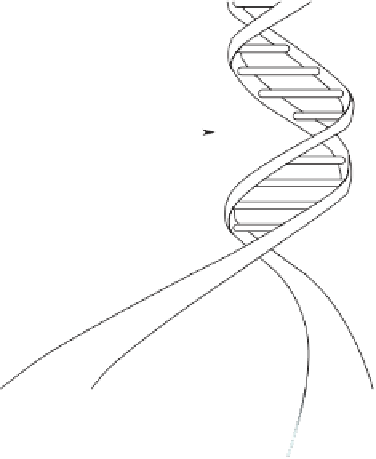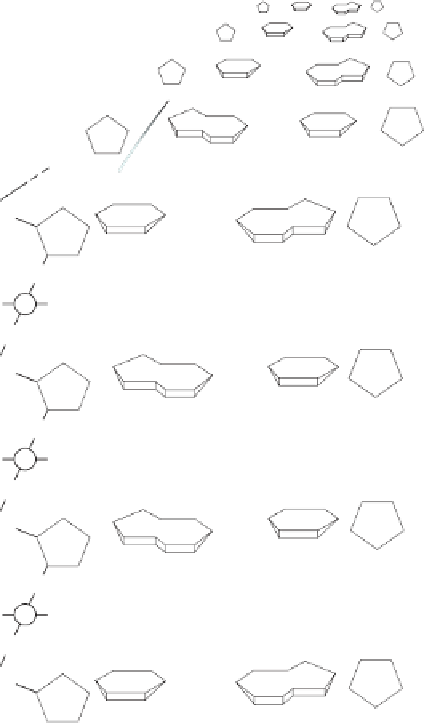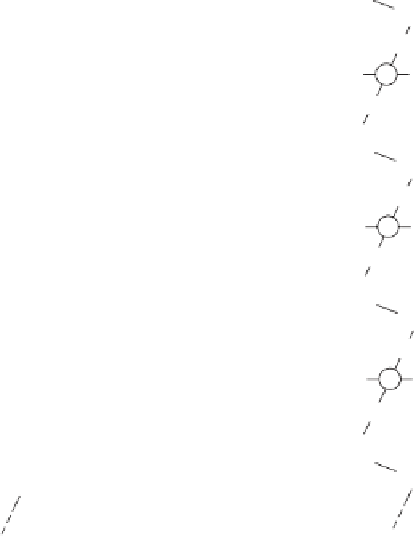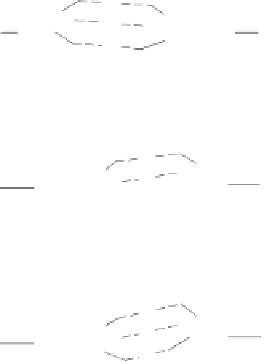Geology Reference
In-Depth Information
As Mendel deduced from his experiments, half of the
genetic makeup of a fertilized egg comes from each parent. The
fertilized egg, however, develops and grows by a cell-division
process called
mitosis
during which cells are simply duplicated;
that is, there is no reduction in the chromosome number as in
meiosis (Figure 18.6c).
Twisting of the two
nucleotide strands
into a double helix
During the 1930s and 1940s, the ideas developed by paleon-
tologists, geneticists, population biologists, and others were
merged to form a
modern synthesis
or neo-Darwinian view
of evolution. The chromosome theory of inheritance was
incorporated into evolutionary thinking; changes in genes
(mutations) were seen as one source of variation in popula-
tions; Lamarck's idea of inheritance of acquired characteris-
tics was completely rejected; and the importance of natural
selection was reaffi rmed. Furthermore, populations rather
than individuals evolve. An individual organism retains the
same genes during its life, but it may have a variation not
present in most members of its population, or a genetic mu-
tation may occur that can be passed on to its descendants. In
either case, the frequency of a particular trait may change in a
population. In short, variations are found in individuals and
mutations take place in genes; individuals are selected if their
variations are favorable, and as a result, populations evolve.
H
H
H
CH
2
C
O
O
P
O
O
H
H
CH
2
A
Natural selection works on variations in populations, most of
which result from the reshuffling of alleles from generation
to generation during sexual reproduction. Given that each of
thousands of genes might have several alleles, and that off-
spring receive half of their genes from each parent, the potential
for variation is enormous. Any new variations arise by
muta-
tions
involving some kind of change in the chromosomes
or genes—that is, a change in the hereditary information.
Whether a
chromosomal mutation
(affecting a large segment of
a chromosome) or a
point mutation
(a change in a particular
gene), as long as it takes place in a sex cell, it is inheritable.
To fully understand mutations, we must explore them
further. For one thing, they are random with respect to fi t-
ness, meaning they may be benefi cial, neutral, or harmful. If
a species is well adapted to its environment, most mutations
would not be particularly useful and might be harmful. But
what was a harmful mutation can become a useful one if the
environment changes. For instance, some plants have devel-
oped a resistance to contaminated soils around mines. Plants
of the same species from the normal environment do poorly
or die in contaminated soils, whereas contaminant-resistant
plants do very poorly in the normal environment. Mutations
for contaminant resistance probably occurred repeatedly in
the population, but they were not benefi cial until contami-
nated soils were present.
How can a mutation be neutral? In cells, information
carried on chromosomes directs the formation of proteins
by selecting the appropriate amino acids and arranging them
into a specifi c sequence. However, some mutations have no
O
O
P
O
O
H
H
H
CH
2
G
O
O
P
O
O
H
H
CH
2
T
◗
Figure 18.5
Deoxyribonucleic Acid (DNA) Diagram of the
double-stranded, helical DNA molecule. The molecule's two strands
are joined by hydrogen bonds (H). Notice the bases A, G, C, and T,
combinations of which code for amino acids during protein synthesis
in cells.
In sexually reproducing organisms,
sex cells
(pollen and
ovules in plants and sperm and eggs in animals) are pro-
duced when cells undergo a type of cell division known as
meiosis
. This process yields cells with only one chromo-
some of each pair, so all sex cells have only half the chro-
mosome number of the parent cell (
Figure 18.6a). During
reproduction, a sperm fertilizes an egg (or pollen fertilizes
an ovule), yielding an egg (or ovule) with the full set of
chromosomes typical for that species (Figure 18.6b).
◗










































Search WWH ::

Custom Search